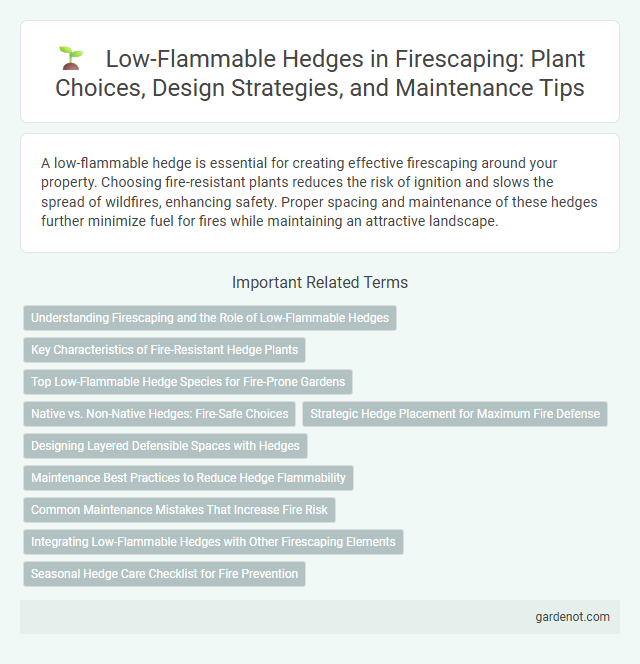A low-flammable hedge is essential for creating effective firescaping around your property. Choosing fire-resistant plants reduces the risk of ignition and slows the spread of wildfires, enhancing safety. Proper spacing and maintenance of these hedges further minimize fuel for fires while maintaining an attractive landscape.
Understanding Firescaping and the Role of Low-Flammable Hedges
Low-flammable hedges play a crucial role in firescaping by acting as natural firebreaks that reduce the spread of wildfires and protect property. These hedges typically consist of plants with high moisture content and low resin or oil levels, such as boxwood or honeysuckle, which resist ignition and slow fire progression. Incorporating low-flammable hedges into landscaping design enhances fire resilience while maintaining aesthetic value and environmental benefits like habitat provision and erosion control.
Key Characteristics of Fire-Resistant Hedge Plants
Fire-resistant hedge plants exhibit high moisture content, thick and dense foliage, and low resin or oil levels, which significantly reduce their flammability. Common examples include boxwood, holly, and lavender, known for their ability to slow fire spread and create effective defensible space. These plants require regular maintenance to remove dead material, further enhancing their fire-resistant properties.
Top Low-Flammable Hedge Species for Fire-Prone Gardens
Manzanita, Ceanothus, and Rosemary are top low-flammable hedge species ideal for fire-prone gardens due to their high moisture content and minimal resin production. These drought-tolerant plants create effective firebreaks and reduce the spread of wildfires when properly maintained and spaced. Incorporating these species into landscape design enhances fire resistance while maintaining aesthetic appeal and ecological benefits.
Native vs. Non-Native Hedges: Fire-Safe Choices
Native low-flammable hedges such as California lilac (Ceanothus spp.) and California coffeeberry (Frangula californica) offer superior fire resistance due to their high moisture content and low resin levels, reducing fire spread risk. Non-native hedges like boxwood (Buxus spp.) and oleander (Nerium oleander) often contain higher oil content, making them more flammable and less suitable for fire-safe landscaping. Selecting native low-flammable hedges enhances fire protection while supporting local ecosystems and biodiversity.
Strategic Hedge Placement for Maximum Fire Defense
Strategic placement of low-flammable hedges enhances fire defense by creating effective fuel breaks that slow wildfire spread near structures. Selecting fire-resistant species such as Texas sage, boxwood, or rosemary in hedges reduces ignition risk while maintaining landscape aesthetics. Positioning these hedges at safe distances from buildings and aligning them with natural firebreaks maximizes their protective function.
Designing Layered Defensible Spaces with Hedges
In firescaping, designing layered defensible spaces with low-flammable hedges enhances wildfire resilience by creating natural firebreaks that slow fire spread. Selecting drought-tolerant, low-resin plants like boxwood or manzanita ensures reduced flammability while maintaining landscape aesthetics. Proper hedge spacing, pruning, and integration with other fire-resistant vegetation form critical components of an effective defensible space strategy.
Maintenance Best Practices to Reduce Hedge Flammability
Pruning low-flammable hedges regularly removes dead or dry branches that can act as fuel for fires, significantly reducing hedge flammability. Consistent watering maintains moisture levels in hedge foliage, decreasing the likelihood of ignition during dry seasons. Applying mulch around the base of hedges not only conserves soil moisture but also acts as a fire-retardant barrier, enhancing overall fire resistance in landscaping.
Common Maintenance Mistakes That Increase Fire Risk
Neglecting regular pruning and allowing dead foliage to accumulate on low-flammable hedges significantly increases fire risk by providing additional fuel for flames. Overwatering low-flammable plants can cause dense, unhealthy growth that traps heat and slows drying, making the hedge more susceptible to ignition. Failing to clear debris from the base of hedges and surrounding areas creates hidden fire hazards that compromise the hedge's fire-resistant properties.
Integrating Low-Flammable Hedges with Other Firescaping Elements
Integrating low-flammable hedges with fire-resistant mulch and strategically placed gravel pathways enhances overall landscape resilience against wildfires. Selecting native, drought-tolerant shrubs such as manzanita or ceanothus strengthens natural fire barriers while supporting local ecosystems. Combining these hedges with well-maintained irrigation systems and defensible spaces minimizes ignition risks and promotes safer firescaping designs.
Seasonal Hedge Care Checklist for Fire Prevention
Maintain low-flammable hedges by regularly pruning to remove dead or dry branches, reducing fuel for potential fires. Water hedges deeply during dry seasons to keep foliage moist and resilient against ignition. Clear fallen leaves and debris around hedges to minimize fire hazards and ensure proper maintenance for fire prevention.
Low-flammable Hedge Infographic

 gardenot.com
gardenot.com